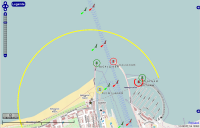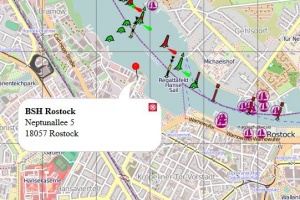h:En:OpenSeaMap in Website
| Deutsch | English |
|---|
You can include OpenSeaMap in various ways to the website:
Inhaltsverzeichnis
Embed as Static Map
The easiest way you show a static image, and link it with the full map of OpenSeaMap:
- Search in OpenSeaMap the appropriate map section
- Press the key
Print, so you copy the whole screen
with the key combination<Alt-Print>you can selectively copy the currently active window - Open an image editing program of your choice and add the screenshot with
<Strg-v> - Draw the desired information (text, lines, circles, areas)
- Save the image on your computer
- Load the image to your Web server
- Include the uploaded image in the article:
<img src="Path/Filename_of_Image" alt="Alternative_text" width="Width" height="Height">
- Link a static map to the full screen map
<imagemap> Image:MapFullscreen.png|right|thumb|200px|with Link to Fullscreen Chart default [1] desc none </imagemap>
You can link the map directly to OpenSeaMap. So by clicking on the map you opens the fullscreen map of OpenSeaMap in a new window. There you can zoom and move freely:
- Search in OpenSeaMap the appropriate map section
- Copy the permalink (on the map bottom right) by
<Ctrl-c> - Add the full permalink to your code by
<Strg-v>
<a href="Permalink">
<img src="Path/Fileame_of_Image" alt="Alternative text" width="Width" height="Height">
</a>
Example:
<a href="http://www.openseamap.org/map/?zoom=18&lat=54.18171&lon=12.08555&layers=BFTTFFTFFTF0FF&lang=de">
<img src="../MapFullscreen.png" alt="show 'Teepott Warnemünde' to the chart" width="200" height="133">
</a>
- Fullscreen chart with Marker and speech bubble
HoTo for displaying a marker plus text in a speech bubble
Embed as Slippy-Map
You can embed OpenSeaMap also dynamically on the site. Users will see your chosen section and the appropriate zoom level in the first load. He can zoom and move freely.
<iframe width="425" height="350" frameborder="0" scrolling="no" marginheight="0" marginwidth="0" src="http://www.openseamap.org/export/embed.html?bbox=-2.01,43.15,13.85,53.35&layer=mapnik" style="border: 1px solid black"></iframe>
<a href="http://www.openseamap.org/?lat=48.25&lon=5.92&zoom=5&layers=BFTTFFTFFTF0FF">Größere Karte anzeigen</a>
The yellow-marked values of the variables have the following meaning:
| width | With of the chart (pixel) |
| height | Height of the chart (pixel) |
| bbox | "Bounding-Box" (the 4 corners of the selected chart) |
| lat | Latitude of the chart center |
| lat | Longitude of the chart center |
| zoom | Zoomlevel of the chart (4...18) |
HTML code to embed in the map:
<html>
<head>
<meta http-equiv="content-type" content="text/html; charset=utf-8"/>
<title>OpenSeaMap</title>
<!-- bring in the OpenLayers javascript library
(here we bring it from the remote site, but you could
easily serve up this javascript yourself) -->
<script src="http://www.openlayers.org/api/OpenLayers.js"></script>
<!-- bring in the OpenStreetMap OpenLayers layers.
Using this hosted file will make sure we are kept up
to date with any necessary changes -->
<script src="http://www.openstreetmap.org/openlayers/OpenStreetMap.js"></script>
<script type="text/javascript" src="http://map.openseamap.org/map/javascript/harbours.js"></script>
<script type="text/javascript" src="http://map.openseamap.org/map/javascript/map_utils.js"></script>
<script type="text/javascript">
var map;
var layer_mapnik;
var layer_tah;
var layer_seamark;
var marker;
// Position and zoomlevel of the map
var lon = 12.0915;
var lat = 54.1878;
var zoom = 15;
var linkText = "Description by SkipperGuide";
function jumpTo(lon, lat, zoom) {
var x = Lon2Merc(lon);
var y = Lat2Merc(lat);
map.setCenter(new OpenLayers.LonLat(x, y), zoom);
return false;
}
function Lon2Merc(lon) {
return 20037508.34 * lon / 180;
}
function Lat2Merc(lat) {
var PI = 3.14159265358979323846;
lat = Math.log(Math.tan( (90 + lat) * PI / 360)) / (PI / 180);
return 20037508.34 * lat / 180;
}
function addMarker(layer, lon, lat, popupContentHTML) {
var ll = new OpenLayers.LonLat(Lon2Merc(lon), Lat2Merc(lat));
var feature = new OpenLayers.Feature(layer, ll);
feature.closeBox = true;
feature.popupClass = OpenLayers.Class(OpenLayers.Popup.FramedCloud, {minSize: new OpenLayers.Size(260, 100) } );
feature.data.popupContentHTML = popupContentHTML;
feature.data.overflow = "hidden";
marker = new OpenLayers.Marker(ll);
marker.feature = feature;
var markerClick = function(evt) {
if (this.popup == null) {
this.popup = this.createPopup(this.closeBox);
map.addPopup(this.popup);
this.popup.show();
} else {
this.popup.toggle();
}
OpenLayers.Event.stop(evt);
};
marker.events.register("mousedown", feature, markerClick);
layer.addMarker(marker);
map.addPopup(feature.createPopup(feature.closeBox));
}
function getTileURL(bounds) {
var res = this.map.getResolution();
var x = Math.round((bounds.left - this.maxExtent.left) / (res * this.tileSize.w));
var y = Math.round((this.maxExtent.top - bounds.top) / (res * this.tileSize.h));
var z = this.map.getZoom();
var limit = Math.pow(2, z);
if (y < 0 || y >= limit) {
return null;
} else {
x = ((x % limit) + limit) % limit;
url = this.url;
path= z + "/" + x + "/" + y + "." + this.type;
if (url instanceof Array) {
url = this.selectUrl(path, url);
}
return url+path;
}
}
function drawmap() {
map = new OpenLayers.Map('map', {
projection: new OpenLayers.Projection("EPSG:900913"),
displayProjection: new OpenLayers.Projection("EPSG:4326"),
eventListeners: {
"moveend": mapEventMove,
//"zoomend": mapEventZoom
},
controls: [
new OpenLayers.Control.Navigation(),
new OpenLayers.Control.ScaleLine({topOutUnits : "nmi", bottomOutUnits: "km", topInUnits: 'nmi', bottomInUnits: 'km', maxWidth: '40'}),
new OpenLayers.Control.LayerSwitcher(),
new OpenLayers.Control.MousePosition(),
new OpenLayers.Control.PanZoomBar()],
maxExtent:
new OpenLayers.Bounds(-20037508.34, -20037508.34, 20037508.34, 20037508.34),
numZoomLevels: 18,
maxResolution: 156543,
units: 'meters'
});
// Add Layers to map-------------------------------------------------------------------------------------------------------
// Mapnik
layer_mapnik = new OpenLayers.Layer.OSM.Mapnik("Mapnik");
// Osmarender
layer_tah = new OpenLayers.Layer.OSM.Osmarender("Osmarender");
// Seamark
layer_seamark = new OpenLayers.Layer.TMS("Seezeichen", "http://tiles.openseamap.org/seamark/", { numZoomLevels: 18, type: 'png', getURL: getTileURL, isBaseLayer: false, displayOutsideMaxExtent: true});
// Harbours
layer_harbours = new OpenLayers.Layer.Markers("Häfen", { projection: new OpenLayers.Projection("EPSG:4326"), visibility: true, displayOutsideMaxExtent:true});
layer_harbours.setOpacity(0.8);
map.addLayers([layer_mapnik, layer_tah, layer_seamark, layer_harbours]);
jumpTo(lon, lat, zoom);
// Update harbour layer
refresh_oseamh();
}
// Map event listener moved
function mapEventMove(event) {
// Update harbour layer
refresh_oseamh();
}
</script>
</head>
<!-- body.onload is called once the page is loaded (call the 'init' function) -->
<body onload="drawmap();">
<!-- define a DIV into which the map will appear. Make it take up the whole window -->
<div style="width:100%; height:100%" id="map"></div>
</body>
</html>
Tile-Server
The OpenSeaMap tile server is accessible at this URL:
http://tiles.openseamap.org/seamark/
- Seamark-Layer
The seamark-layer is added with the following lines:
var layer_seamark = new OpenLayers.Layer.TMS ( "seamark", "http://tiles.openseamap.org/seamark/",
{ numZoomLevels: 18, type: 'png', getURL:getTileURL, isBaseLayer:false, displayOutsideMaxExtent:true });
map.addLayer(layer_seamark);
Drupal
In the Drupal-Center-Forum you can find some solutions with MappingKit:
Typo3
In TYPO3 Extension Repository you will find 2 extensions:
- rb_osmsimple (own records for markers)
- ods_osm (Coordinates in fe_users and tt_address records)

